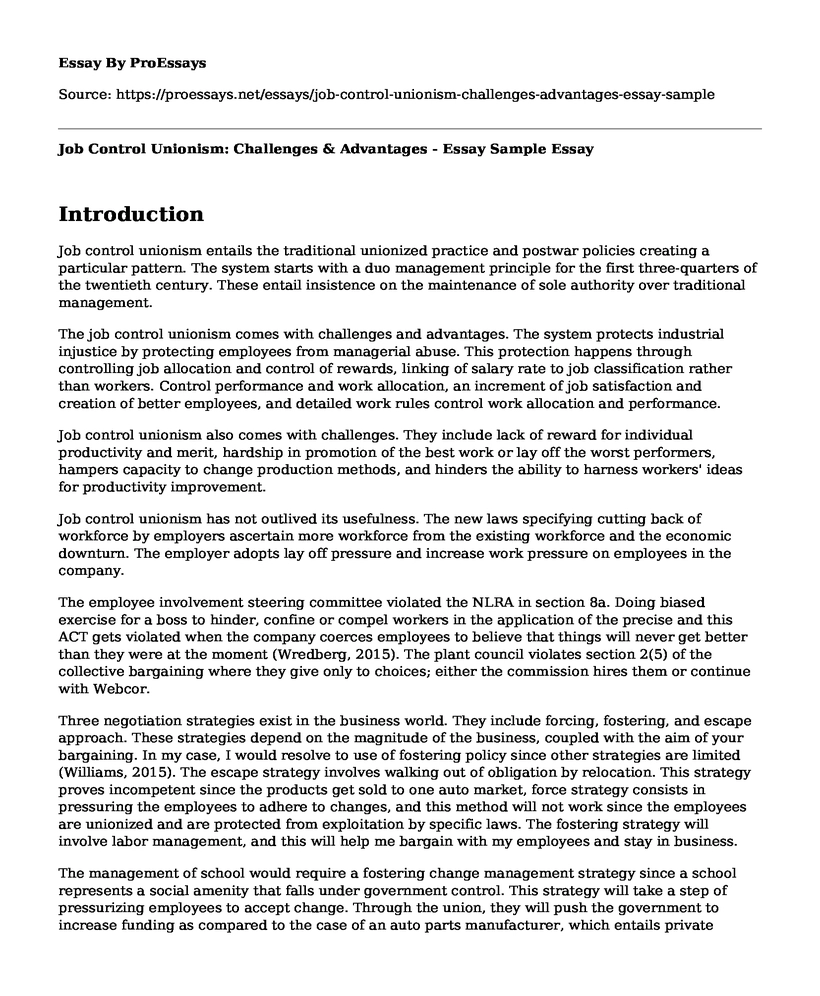Introduction
Job control unionism entails the traditional unionized practice and postwar policies creating a particular pattern. The system starts with a duo management principle for the first three-quarters of the twentieth century. These entail insistence on the maintenance of sole authority over traditional management.
The job control unionism comes with challenges and advantages. The system protects industrial injustice by protecting employees from managerial abuse. This protection happens through controlling job allocation and control of rewards, linking of salary rate to job classification rather than workers. Control performance and work allocation, an increment of job satisfaction and creation of better employees, and detailed work rules control work allocation and performance.
Job control unionism also comes with challenges. They include lack of reward for individual productivity and merit, hardship in promotion of the best work or lay off the worst performers, hampers capacity to change production methods, and hinders the ability to harness workers' ideas for productivity improvement.
Job control unionism has not outlived its usefulness. The new laws specifying cutting back of workforce by employers ascertain more workforce from the existing workforce and the economic downturn. The employer adopts lay off pressure and increase work pressure on employees in the company.
The employee involvement steering committee violated the NLRA in section 8a. Doing biased exercise for a boss to hinder, confine or compel workers in the application of the precise and this ACT gets violated when the company coerces employees to believe that things will never get better than they were at the moment (Wredberg, 2015). The plant council violates section 2(5) of the collective bargaining where they give only to choices; either the commission hires them or continue with Webcor.
Three negotiation strategies exist in the business world. They include forcing, fostering, and escape approach. These strategies depend on the magnitude of the business, coupled with the aim of your bargaining. In my case, I would resolve to use of fostering policy since other strategies are limited (Williams, 2015). The escape strategy involves walking out of obligation by relocation. This strategy proves incompetent since the products get sold to one auto market, force strategy consists in pressuring the employees to adhere to changes, and this method will not work since the employees are unionized and are protected from exploitation by specific laws. The fostering strategy will involve labor management, and this will help me bargain with my employees and stay in business.
The management of school would require a fostering change management strategy since a school represents a social amenity that falls under government control. This strategy will take a step of pressurizing employees to accept change. Through the union, they will push the government to increase funding as compared to the case of an auto parts manufacturer, which entails private ownership.
Job control unionism has over a long period provided security to both the workers and the employees in the business world by ensuring that both the employer and the employee gets equal justice in the work sector (Williams et al. 2015). Job control unionism might contribute to the success of a firm or its failure since some job control unionism act as obstacles to the smooth running of the business. The people in the business sector can choose whether to involve themselves in the job control unionism sector. The world grows at a very high rate, and everyone aims at maximizing profit. This policy ensures protection during the profit maximization process.
References
Sinwell, L. (2015). 'AMCU by day, workers' committee by night': Insurgent Trade Unionism at Anglo Platinum (Amplats) mine, 2012-2014. Review of African Political Economy, 42(146), 591-605.Retrieved from http://www.academia.edu/download/41077330/AMCU_by_Day_ROAPE_2016.pdfhttp://www.academia.edu/download/41077330/AMCU_by_Day_ROAPE_2016.pdf
Williams, M. (2015). Transformative unionism and innovative campaigns challenging inequality. Global Labor Journal, 6(3), 253-266.Retrieved from https://www.researchgate.net/profile/Michelle_Williams41/publication/283038371_Transformative_Unionism_and_Innovative_Campaigns_Challenging_Inequality/links/56cc5e8908ae5488f0dcf8ff.pdf
Wredberg, N. (2015). Subverting Workers' Rights: Class Action Waivers and the Arbitral Threat to the NLRA. Hastings LJ, 67, 881.Retrieved from https://repository.uchastings.edu/cgi/viewcontent.cgi?article=1055&context=hastings_law_journal
Cite this page
Job Control Unionism: Challenges & Advantages - Essay Sample. (2023, Feb 23). Retrieved from https://proessays.net/essays/job-control-unionism-challenges-advantages-essay-sample
If you are the original author of this essay and no longer wish to have it published on the ProEssays website, please click below to request its removal:
- Paper Example on Work-Family Conflict
- Mental Health Access Issue in Massachusetts Paper Example
- Expository Essay on Political Corruption Debate in Congress
- News Frames and Priming of War on Drugs Essay Example
- Essay Sample on Politics and Government: Exploring Terms and Their Significance
- Paper Example on Sexual Harassment in Business: Quid Pro Harassment
- Paper Example on Contingency Planning: Ensuring Employee Safety in Emergencies







